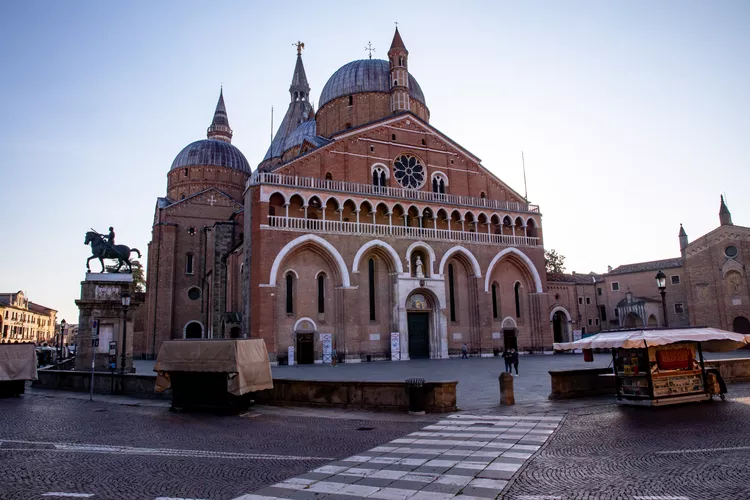Summary
Padua is in the Veneto region of Italy, around 40km from Venice. It is home to the Basilica di Sant’Antonio, frescoes by Giotto, and Europe’s first botanical garden.
How to Get There
You can take the train to Venice and be in the heart of things in less than half an hour. Padua is also a popular stop on the way to Verona, Milan, or Florence.
Padova is a walled city situated along the Bachiglione River between Verona and Venice. If you come by train, the station (Stazione Ferroviania) is on the north side of town. The Basilica and Botanical gardens are found on the southern edge of town. Either the Corso del Popolo or the Viale Codalunga heading south will take you into the old center of town.
Attractions in a Nutshell
Between the train station and the main part of Padua’s historic center is the Scrovegni Chapel, consecrated in 1305. Don’t miss the Giotto frescoes inside.
The celebrated Basilica Pontificia di Sant’Antonio di Padova, sometimes referred to as La Basilica del Santo, is a must-visit. Construction began around 1232, shortly after the death of Sant’Antonio; his relics are housed in the baroque Treasury Chapel. There is a museum inside, featuring the Anthonian Museum, as well as an exhibit detailing the life of Saint Anthony and his legacy today. Two cloisters are available for exploration, making it one of the most significant religious complexes you’ll encounter.
Remarkable places to stroll include the university on the east side of Via III Febbraio (the anatomy theater, built in 1594, is the oldest of its kind and can be visited on the Palazzo Bo tour), Piazza Cavour, the city’s heart, and Prato Della Valle, the largest public square in Italy.
When it’s time for a drink, head over to the 18th-century Pedrocchi Café. This elegant bar and restaurant played a role in the 1848 riots against the Hapsburg monarchy.
Between Sant’Antonio and the Prato della Valle lies Padua’s remarkable Orto Botanico.
The symbol of Padua is the Palazzo della Ragione, the epicenter of the old town, surrounded by market squares piazza delle Erbe and piazza dei Frutti.
Where to Stay
The Hotel Grand’Italia is conveniently located in front of the train station, making it ideal for travelers who prioritize accessibility. This four-star Art Deco hotel is air-conditioned and offers free Internet access.
The Hotel Donatello is situated directly across the street from the Basilica di Sant’Antonio and features a restaurant called Ristorante S. Antonio.
Food and Restaurants
While it may surprise some, Paduans have enjoyed horse meat for centuries. If you’re open to trying it, consider Sfilacci di Cavallo, which is made by slow-cooking the leg, then smoking it, and finally shredding it into threads resembling saffron strands.
Although risotto typically takes precedence over pasta, there are several renowned bigoli (a type of thick spaghetti) dishes available, often plated with duck ragu or anchovies. Additionally, Pasta e Fagioli, a hearty pasta and bean soup, is a signature dish of the region.
Duck, goose, and piccione (squab or pigeon) are also popular local delicacies.
The culinary scene in Padova stands out as a cut above the average fare found in Venice. The best dishes are simple and prepared using fresh ingredients.
A must-try restaurant in Padua is Osteria Dal Capo, located on Via Dei Soncin, across the piazza del Duomo. Although the sign on the door indicates an opening time of 6 pm, it’s best to arrive closer to 7:30 pm. The restaurant offers moderate prices, good house wine, and a menu that changes daily, featuring typical Veneto cuisine. English is spoken, although having a basic understanding of Italian can enhance your experience.
Before dinner, consider enjoying an aperitivo (try the classic Italian Campari soda) at one of the two cafes vying for customers in the Piazza Capitaniato, located to the north of the Duomo. Each cafe attracts a different crowd, ensuring a lively atmosphere. A wine bar is also available further north on Via Dante.
The Orto Botanico (Botanical Gardens)
Today, visitors can explore the Botanical Gardens in Padua, which features a palm tree planted in 1585. The Arboretum includes a large plane tree that has stood since 1680, its trunk hollowed by a lightning strike.
In Padua’s botanical garden, plants are grouped into collections based on their characteristics. Notable collections include:
- Insectivorous plants – A collection dedicated to the carnivorous members of the plant kingdom.
- Medicinal and poisonous plants – This category reflects the historical mission of the garden’s establishment in 1545.
- Itinerary for blind people – Aromatic and thorny plants feature in pots that can be changed seasonally, with labels provided in Braille.
- Aquatic plants – Marvel at the diversity of lilypads from around the world.
The botanical gardens are located just south of the Basilica di Sant’Antonio. To access them, walk south along the street that parallels the front of the Basilica.





